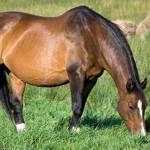Feeding for Fertility

For many horse managers, the goal of breeding season is to have last year’s open mares in foal and this year’s pregnant mares back in foal within a few weeks of foaling. As for stallions, it is time to show the world what they’re made of!
When asked what she thought was the most important nutritional aspect of reproductively active horses, Kathleen Crandell, Ph.D., a nutritionist for Kentucky Equine Research (KER) said, “For mares, avoid endophyte-infected tall fescue from 300 days gestation through lactation and feed mares to be in good body condition during lactation and when coming back into breeding. For stallions, feed to avoid obesity.”
Mares
Broodmares can be divided into one of the five following categories: maiden mares; barren and early pregnant, nonlactating mares (0–4 months of gestation); mares in midpregnancy (5–8 months of gestation); mares in late pregnancy (9–11 months of gestation); and lactating mares (early and late, and including pregnant). Mares should be individually assessed during each of these phases to ensure their nutritional needs are being met and their body condition is appropriate. It can be difficult to assess body condition in pregnant mares. According to Crandell, ribs should be easily felt but not seen.
“Some mares lose a substantial amount of weight during lactation, especially if they are in foal as well. Ensuring these horses are in good condition as they head back into the breeding season is important,” advises Crandell.
Stallions
“Stallions that are too fat have a greater risk of injury while serving a mare, particularly early in the season, and are more likely to lose enthusiasm later in the breeding season,” advised Peter Huntington, B.V.Sc., M.A.C.V.Sc., director of nutrition, KER Australia. “Overfeeding grain can also lead to an increased risk of laminitis, colic, and diarrhea.”
Crandell adds, “Stallions should be maintained on diets designed to provide the recommended intake of forage and satisfy their caloric needs and nutrient requirements. The stallion’s diet should provide the appropriate amount of calories to maintain the horse in optimal condition, avoiding excessive thinness or obesity.”
In terms of supplements, there is a wide variety of products designed to support and possibly enhance stallion fertility, including vitamins (specifically A and E), omega-3 fatty acids (including EPA and DHA), antioxidants, and more. EO-3, a nutritional supplement developed by Kentucky Equine Research (KER), is a rich source of EPA and DHA, and supports sperm concentration, motility, and viability.
As with any supplement, choose your product wisely to avoid poor-quality supplements that are unlikely to be effective.








